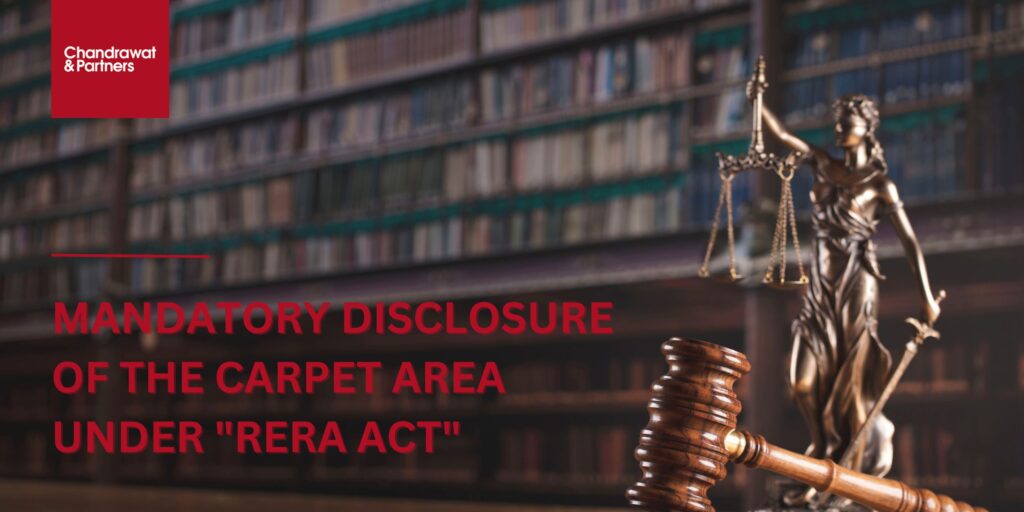Mandatory disclosure of the carpet area under RERA Act
It would be pretty fair to state that the real estate sector is perhaps one of the substantial contributors to economic growth and development in India. Residential real estate sales grew by 60% in the first half of 2022 to 158,705 units across the top eight cities in the country from 99,416 units in the same period last year. Home sales in the National Capital Region (NCR) centred on New Delhi grew 154%, according to a report released on July 6.
The introduction of the Real Estate (Regulation and Development) Act, 2016 (hereinafter referred as “the Act”) has also reconstructed the dynamics of selling and buying properties throughout the nation. Ever since the Act has been implemented, the builders have been instructed to sell the flat, apartment, or building based on the carpet area.
Carpet area under the Act
The Real Estate Act has made it mandatory for developers to disclose the carpet area of the apartments they sell. The Act has sorted out the ambiguities by clarifying the definition of ‘carpet area’. The carpet area elucidation has been proven fruitful for homebuyers as they have been liberated from being misinformed and duped by the developers. The Real Estate (Regulation and Development) Act, defines carpet area as ‘the net usable floor area of an apartment, excluding the area covered by the external walls, areas under services shafts, exclusive balcony or verandah area and exclusive open terrace area, but includes the area covered by the internal partition walls of the apartment’.
Earlier, builders used to perplex homebuyers by booking the flat/apartment based on the super built up area. As a result, the homebuyers were intermittently deceived by the developers. Nevertheless, now it is mandatory for the builders to book the property/apartment based on the carpet area. Furthermore, they will know exactly what part of the flat is included in the carpet area and what part is included in the verandas and terraces.
Built up area and Super built up area
The built-up area of a premise is measured from the external perimeter wall surfaces. It is the carpet area plus the wall thickness along with other unusable areas within the apartment such as the dry balcony, terrace, flower beds, etc. Built up area would always be more than the carpet area.
The Super Built-up area of a premise is the saleable area, which includes the carpet area, along with the terrace, balconies, areas occupied by walls, and area occupied by common/shared construction (e.g. lift, stairs, etc). In some cases, builders include amenities like a pool, clubhouse, and garden. Builders use the loading factor on the carpet area to arrive at the super built-up area.
According to Real Estate Regulatory Authority (RERA), the carpet area, built-up area, as well as the share of the common area like stairs, lobbies, that can be used by the entire building is defined as Super Built-up area.
How would a defined carpet area help homebuyers?
- Buyers will have the exact information about the area of a flat they can expect to receive from the developer. They will know what amount of space will be included in the carpet area and what part will be for the balconies, verandas, and so on.
- Abiding by the standardized definition of carpet area, developers that bring up new real estate projects will be more particular with their plans, to ensure that they deliver what has been promised.
- Backed by accurate knowledge of a project site, plot, and its layout, buyers will be in a better position to make their buying decisions. Furthermore, it will also get easier for property owners to identify their rights and the tax liability on the property.
Impact of Change in carpet area
The Real Estate (Regulation and Development) Act directive is not just limited to making the mention of the carpet area mandatory. There is also a rule that if the actual carpet area is reduced at the time of handover, the difference must be refunded by the developer to the buyer.
On the flip side, the home buyer will have to pay extra if the carpet area increases. But there is a relief given to the buyer in the form of the increase being restricted to 3% only.
The real estate law stipulates that the refund from the developer has to be made within 45 days along with interest. In the case of an increase, the developer needs to inform the buyer beforehand and ask for the increased amount during the next due payment. In both cases, the same rate per square feet will be used to calculate the increase or decrease in price.
Carpet area in the post covid-19 world
Buyers will now understand the exact measurement of the flat they can reasonably expect to receive from the developer. Furthermore, they will know exactly what part of the flat is included in carpet area and what part is included in verandas and terraces. Additionally, developers will have to be more stringent in planning their projects, to ensure exact rendition of plans to actual carpet area.
The registration of the conveyance deeds is to be done only on the basis of the Carpet Area. While in a case where the conveyance deed of the units has not been executed, the promoter shall also indicate the Carpet Area in addition to the Super Area and its details/constituents.
For more information or queries, please email us at
[email protected]





